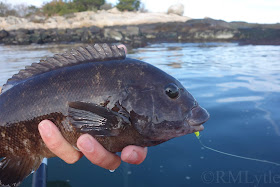Noah and I are running out of local lifers, especially large local lifers. Especially in freshwater where we really had only a handful of micros and endangered species (which we don't target, for obvious reasons). The only freshwater "gamefish" I had left to catch in CT were tiger musky and kokanee, Noah only had kokanee since hasn't counted hybrids. We had to get kokanee this year. Last year we tried one time. It was too late, too cold, too windy, too snowy, on and on and on. It was just an extremely poor fishing day. Our only day targeting kokanee this year was the polar opposite, an absolutely lovely fall day to be up in the Northwestern CT hills. Now, I guess I should give some background for those of you that don't know what a kokanee is. Kokanee are the landlocked for of sockeye salmon, having naturally diverged roughly 15,000 years ago when melting glaciers facilitated their geographic isolation from sea run sockeye. Sockeye are a strange salmonid, continuing to feed on zooplankton almost exclusively through their entire lives. As such they don't rise to hatches or feed on baitfish, and the fishing methods used to catch kokanee outside of spawning season can be quite unique. Like their other Pacific salmon brethren though, they let their guard down during the spawning run and can be aggravated into striking flies and lures. Also like Pacific salmon, when they start the spawning process, that's the beginning of their end. They die after they spawn. CT DEEP maintains a small number of stillwater kokanee fisheries through capturing adults before they spawn then stocking the offspring back into those bodies of water. They likely wouldn't produce a wild fishery on their own, but it is interesting to have these fish available to us.

Noah and I wanted to time our trip to coincide with the spawn, preferably fairly early when the fish are the most fired up and easily triggered into striking. I started to get a little nervous when we circumnavigated the lake and saw only two carcasses that had been there a while. It wasn't until we got all the way around the lake and back to where we'd started that we found a bunch of kokanee. Noah hooked and boated one one his first cast into the school, of course it flipped right out of the kayak and we then both struggled for a long time to land one. Getting them to strike wasn't actually that difficult. Changing tactic frequently and just sticking to it got results. The fish would seemingly ignore a presentation for a long time before suddenly slamming it, or just progressively get visibly more and more irritated before snapping. We both got tons of takes, but a combination of factors including the small size of the fish, their jumping, and their tooth filled narrow mouths made them very hard to hook and keep hooked. Almost no takes resulted in hooked fish, and most of the fish we hooked threw the lure or fly. To make things even more frustrating, the fish were grouped tightly and moving about, so they often snagged themselves. I stuck mostly with barbless hooks so I could shake off snagged fish. Evidently people are going specifically to snag these fish. While we were there a man came along, snagged the biggest female there, and then kept it. Snagging is obviously low, but keeping a rotting, spawning salmon is just stupid. Someone also pulled up next to us and asked "snaggin anything?". People either aren't patient enough or just don't know that these fish will mouth the right presentations. Or they don't care, and that's honestly probably the case. Noah and I could have snagged every kokanee in this place twice pretty easily and then taken tons of photos to share all over social media. But what really would the point of that be?
No, we were struggling to catch any at all, but if I was going to catch a kokanee it had to eat the fly.
And lucky for me one did, I hooked it, it stayed on through a couple of jumps, and it didn't shake the hook until I had it in shallow water where I could keep it from making a break for it. I edged on step closer to my goal of reaching #150 before the end of 2019.
 |
| Lifelist fish #142, sockeye salmon (kokanee salmon), Oncorhynchus nerka, Rank: species |
Noah eventually got one too, and we soon left those obnoxious little demons to their business. Honestly, I'll need an entire year to forget how frustrating they were to want to go try to catch one again. I'd love to try to get them in a river, that seems like a lot more fun, but I'm fairly certain that closest that kind of fishery exists in Colorado.
So, now I'm down to a dismally low number of local species I still need to catch. This is getting hard. Time to move!
Until next time.
Fish for the love of fish.
Fish for the love of places fish live.
Fish for you.
Thank you to my Patrons; Erin, David, john, Elizabeth, Chris, Brandon, and Christopher, for supporting this blog on Patreon.





















































